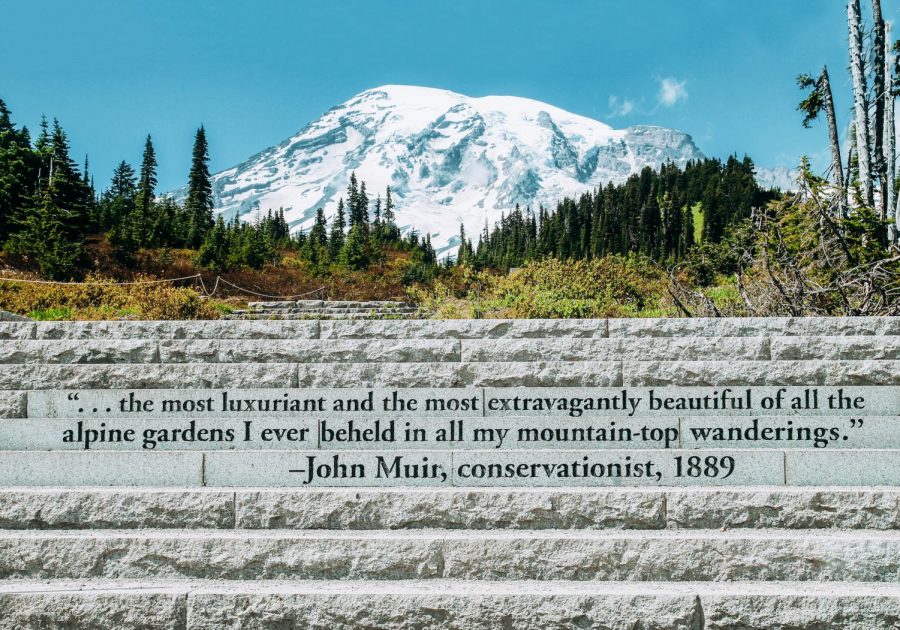From the mountains to the sea
Increased fees will benefit national park maintenance
Mount Rainier is one of the largest national parks in Washington and attracts many outdoor tourists.
November 9, 2017
President Trump’s proposed federal budget for 2018 cuts $1.5 billion from the Department of the Interior, which oversees the country’s National Park Service (NPS). This led to a plan to increase peak-season admission fees.
“The infrastructure of our national parks is aging and in need of renovation and restoration,” U.S. Secretary of the Interior Ryan Zinke said in a news release on Oct. 24. “Targeted fee increases at some of our most visited parks will help ensure that [the parks] are protected and preserved in perpetuity.”
The plan includes the 17 most popular national parks, which includes Olympia and Mt. Rainier, and aims to double entrance fees during their respective peak seasons, but price will remain the same outside of the season.
Peak season for Olympia National Park begins on May 1, while Mt. Rainier’s begins on June 1. If the fees do increase, we can expect them to be put into action by 2018.
“On one hand you’re going to generate revenue to maintain the parks, on the other hand some people can’t go because the cost is prohibitive. It’s a double-edged sword,” said Patrick McCutcheon, an anthropology professor at CWU who has worked on research at Mt. Rainier National Park for roughly six years.
Entrance fees for private, non-commercial vehicles are proposed to go from $30 to $70. Motorcycle admission would double to $50 and by-person/bicycle fees would double to $30.
“Mt. Rainier was one of the first to be allowed to use their fees to conduct repairs,” said McCutcheon, who experienced firsthand what happens when the parks have to cut services as his own research was funded by admission fees. “They had to close the interpretive center at one point and it had a huge impact and there was a large outcry from the public.”
Proceeds from the increased fees go towards maintenance, improvements and staffing at the national parks; including backlogged maintenance, which is necessary work that has to be postponed due to funding or obstruction.
“The backlog maintenance is a real thing. I’ve seen it, they’ll have to close parts of the park for safety reasons, then it’s not available to anyone. There needs to be access,” McCutcheon said.
It’s not uncommon for national parks to shut down services or parts of the park due to unsafe conditions or lack of staffing when confronted with large attendance numbers.
“Anyone who wants to see the national parks should be willing to pay to keep them beautiful and make sure they stay accessible for future generations,” Guy Spalinger said, a senior recreation management major and president of CWU’s Adventure Club.
While Adventure Club hasn’t been able to make a trip out to Olympic or Mt. Rainier National Park, Spalinger said that it’s highly likely that they’ll plan a trip to one during the spring in the upcoming years.
“At this point a lot of national parks don’t have enough money to keep the parks looking nice and easily accessible,” Spalinger said. “The reason people go to these parks is because they’re beautiful, if we want to see these places we’ll have to put in money to keep it that way.”
However, aside from admission fees, visitors have to consider the overall cost of the trip.
“When you look at populations visiting, it’s more of the middle to lower class. This increase could be quite an issue for these people,” Spalinger said.
This could include gas spent through traveling, meals when arriving if they’re eating on site, potential souvenirs and a place to stay if it’s an overnight trip.
“Can a family earning minimum wage afford a one-time pass, or a full pass? You have to consider the full cost of a trip like that,” McCutcheon said.
To encourage individuals to keep visiting, an annual one-park pass is being offered at $75.
The National Parks and Federal Recreational Lands Pass, which provides entrance to all federal lands and parks for a one-year period, would remain $80.
“We need to have the vision to look at the future of our parks and take action in order to ensure that our grandkids’ grandkids will have the same if not better experience than we have today. Shoring up our parks’ aging infrastructure will do that,” Zinke said in the statement.
Current estimates say that the fee increase could collect $70 million annually, with 80 percent of what’s earned in each park staying there for use and the remaining 20 percent going towards other parks in need of financial aid.

